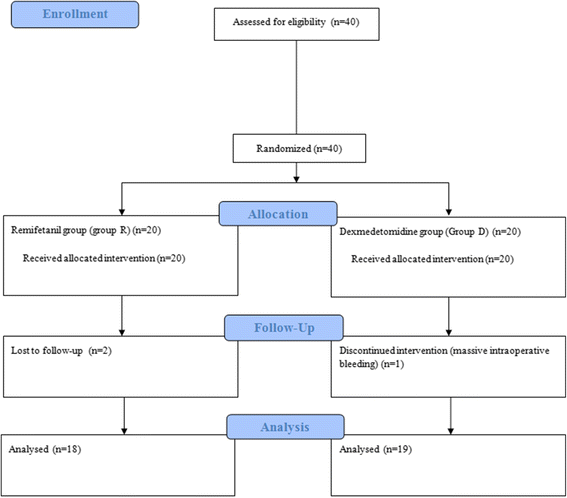Dexmedetomidine versus remifentanil in postoperative pain control after spinal surgery: a randomized controlled study
- PMID: 25750586
- PMCID: PMC4352285
- DOI: 10.1186/s12871-015-0004-1
Dexmedetomidine versus remifentanil in postoperative pain control after spinal surgery: a randomized controlled study
Abstract
Background: Total intravenous anesthesia (TIVA) is used widely in spinal surgery because inhalational anesthetics are known to decrease the amplitude of motor evoked potentials. Presently, dexmedetomidine is used as an adjuvant for propofol-based TIVA. We compared the effects of remifentanil and dexmedetomidine on pain intensity as well as the analgesic requirements after post-anesthesia care unit (PACU) discharge in patients undergoing spinal surgery.
Methods: Forty patients scheduled for posterior lumbar interbody fusion (PLIF) surgery under general anesthesia were enrolled. Anesthesia was maintained using propofol at 3-12 mg/kg/h and remifentanil at 0.01-0.2 μg/kg/min in Remifentanil group or dexmedetomidine at 0.01-0.02 μg/kg/min in Dexmedetomidine group, keeping the bispectral index between 40 and 60. Patient-controlled analgesia (PCA) made of hydromophone was applied once the patients opened their eyes in the PACU. The visual analog scale (VAS) score, PCA dosage administered, and postoperative nausea and vomiting (PONV) were recorded at the time of discharge from the PACU (T1) and at 2 (T2), 8 (T3), 24 (T4), and 48 hours (T5) after surgery.
Results: The VAS score in Remifentanil group was significantly higher than that in Dexmedetomidine group at immediate and late postoperative period (4.1 ± 2.0 vs. 2.3 ± 2.2 at T1, and 4.0 ± 2.2 vs. 2.6 ± 1.7 at T5; P < 0.05). Dexmedtomidine group had a statistically significantly lower PCA requirement at every time point after surgery except directly before discharge from the PACU (3.0 ± 1.2 ml vs. 2.3 ± 1.4 ml at T1; P > 0.05, but 69.7 ± 21.4 ml vs. 52.8 ± 10.8 ml at T5; P < 0.05). Patients in Remifentanil group displayed more PONV until 24 hours post-surgery.
Conclusions: Dexmedetomidine displayed superior efficacy in alleviating pain and in postoperative pain management for 48 hours after PLIF. Therefore, dexmedetomidine may be used instead of remifentanil as an adjuvant in propofol-based TIVA.
Trial registration: Clinical Research Information Service (CRiS) Identifier: KCT0001041.
Keywords: Dexmedetomidine; Postoperative pain; Remifentanil; Total intravenous anesthesia.
Figures



References
-
- Sekimoto K, Nishikawa K, Ishizeki J, Kubo K, Saito S, Goto F. The effects of volatile anesthetics on intraoperative monitoring of myogenic motor-evoked potentials to transcranial electrical stimulation and on partial neuromuscular blockade during propofol/fentanyl/nitrous oxide anesthesia in humans. J Neurosurg Anesthesiol. 2006;18(2):106–11. doi: 10.1097/00008506-200604000-00003. - DOI - PubMed
-
- Zheng Y, Cui S, Liu Y, Zhang J, Zhang W, Zhang J, et al. Dexmedetomidine prevents remifentanil-induced postoperative hyperalgesia and decreases spinal tyrosine phosphorylation of N-methyl-d-aspartate receptor 2B subunit. Brain Res Bull. 2012;87(4–5):427–31. doi: 10.1016/j.brainresbull.2012.01.009. - DOI - PubMed
Publication types
MeSH terms
Substances
Associated data
LinkOut - more resources
Full Text Sources
Other Literature Sources
Medical

